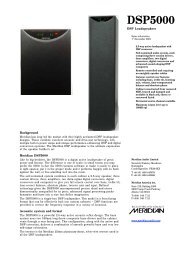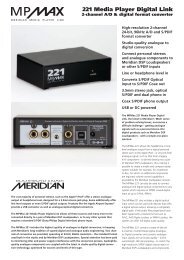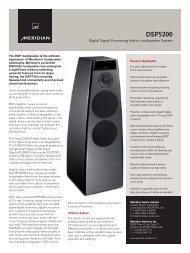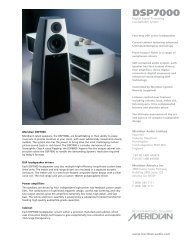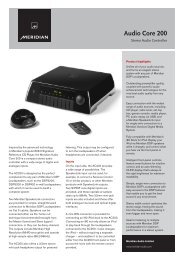The Sound of Minute Repeaters Bob Stuart - meridian-audio[.info]
The Sound of Minute Repeaters Bob Stuart - meridian-audio[.info]
The Sound of Minute Repeaters Bob Stuart - meridian-audio[.info]
You also want an ePaper? Increase the reach of your titles
YUMPU automatically turns print PDFs into web optimized ePapers that Google loves.
<strong>The</strong> <strong>Sound</strong> <strong>of</strong> <strong>Minute</strong> <strong>Repeaters</strong><br />
<strong>Bob</strong> <strong>Stuart</strong><br />
Meridian Audio (Cambridge)<br />
Striking Clocks<br />
Through history, striking clocks which mark the hours<br />
were invaluable in the regulation <strong>of</strong> communities.<br />
Domestic long-case striking clocks are very familiar<br />
and <strong>of</strong>ten treasured.<br />
<strong>The</strong> 17 th -century repeater was an invention from<br />
necessity; how to know the time in the dark without<br />
waiting for the chimes?<br />
In contrast to broadcasting clocks, one’s relationship<br />
with a repeater is quite different and strictly personal;<br />
the time is told more precisely and on demand.<br />
Although the primary need has gone, there is no doubt<br />
that adding this complication to a watch is a significant<br />
engineering feat. But because it is a watch and<br />
therefore smaller, the sound that results is different in<br />
both scale and quality to that <strong>of</strong> a striking clock.<br />
<strong>The</strong> minute-repeater sound<br />
<strong>The</strong> watches we tested had a common feature: to ‘hear’<br />
the time one slides a lever on the left side <strong>of</strong> the body.<br />
This action winds a separate spring so that the main<br />
power is not disturbed and starts a regulating<br />
mechanism which sequences through the chimes.<br />
<strong>The</strong> scope <strong>of</strong> a minute repeater is therefore within<br />
arm’s reach and because <strong>of</strong> its size, the quantity <strong>of</strong><br />
sound generated, whilst enough at 0.5m, is not for<br />
sharing in a room. If the watch is held to the ear it is<br />
highly audible and if it is placed on a table then the<br />
sound can be much amplified, just as one hears with a<br />
tuning fork. 1<br />
<strong>The</strong>se watches have two different gongs inside: one to<br />
strike the hours, another, higher in pitch, for the<br />
minutes, while both in rapid low–high sequence<br />
indicate the quarters.<br />
Each gong sound has a hammer strike and a bell-like<br />
tone which gradually decays. <strong>The</strong> overall sound<br />
sequence has four more components: the regular tick,<br />
the initial sound <strong>of</strong> winding the repeater mechanism, a<br />
whirring from the chime regulator and in some, a click<br />
at the sequence end. <strong>The</strong>se elements can all be seen in<br />
the picture below.<br />
This graph shows the sound wave (left to right) for the<br />
Vacheron Constantin striking 7:59 (seven hours; three<br />
quarters and 14 additional minutes). <strong>The</strong> steady buzz<br />
between each chime is the regulator.<br />
<strong>The</strong>se mechanical devices show small irregularities<br />
between strikes, and indeed part <strong>of</strong> the charm is that the<br />
sound is different every time.<br />
<strong>The</strong> gongs themselves are normally curved metal rods<br />
which fit around the inside <strong>of</strong> the body, as can be seen<br />
in the picture below.<br />
This picture shows the two gong rods curling round the<br />
outside, clamped between the two hammers.<br />
1 Some makers provide sound-box accessories to boost<br />
the level, but we did not test these.<br />
Vanity Fair: <strong>The</strong> <strong>Sound</strong> <strong>of</strong> <strong>Minute</strong> <strong>Repeaters</strong> 1
<strong>Bob</strong> <strong>Stuart</strong><br />
<strong>The</strong> dimensions and material <strong>of</strong> the gong govern the<br />
pitch <strong>of</strong> the note and the structure and decay <strong>of</strong> the<br />
overtones. <strong>The</strong> persistence <strong>of</strong> the lower – so-called<br />
‘hum tone’ <strong>of</strong> the gong – is also modified by the body<br />
<strong>of</strong> the watch and whether it rests on a wrist. <strong>The</strong> sound<br />
<strong>of</strong> each gong is similar to a chime or bell and, as with<br />
all percussion instruments, the exact location and<br />
duration <strong>of</strong> the strike action affects the sound. So there<br />
is a great deal the watchmaker can do to ‘tune’ the<br />
sound <strong>of</strong> each chime in addition to just picking the<br />
fundamental notes. As we found in listening, some<br />
were much more elegant or musical than others.<br />
How we tested<br />
We settled on a combination <strong>of</strong> measurement, analysis<br />
and listening tests for all eight watches in the group.<br />
Reflecting its use, we captured the sound <strong>of</strong> each watch<br />
on both a table-top and wrist, using a high-quality<br />
recording system at the close range <strong>of</strong> 6cm. <strong>The</strong>se<br />
recordings were made in Meridian’s anechoic chamber<br />
– this special room floats on a suspension and is lined<br />
so that it is totally silent when the door is closed. 2<br />
<strong>The</strong> recordings were then analysed by computer to<br />
estimate the apparent loudness (audibility) and reveal<br />
the harmonic structure, decay and harmonicity <strong>of</strong> each<br />
chime.<br />
Listening panel<br />
Measurements allow us to put some meat on the bones,<br />
but these watches are meant to be enjoyed – and that<br />
means listening.<br />
We decided to recruit a panel whose vocation includes<br />
the creation and analysis <strong>of</strong> sound, and were delighted<br />
that John Rutter agreed to join us. John’s renowned<br />
skills as composer, choral director and recording<br />
producer brought a unique perspective. Another<br />
member, Melvyn Goldsmith, is a respected UK violinmaker<br />
whose intuition on the relationship between<br />
materials and the resulting sound was invaluable. I was<br />
able to add psychoacoustic insights and the experience<br />
<strong>of</strong> designing high-quality sound systems. Together with<br />
Nick Foulkes, this panel was able to clearly articulate<br />
the nuances <strong>of</strong> each individual watch.<br />
For the listening we used a quiet room. <strong>The</strong> recordings<br />
were first replayed at high resolution using a pair <strong>of</strong><br />
Meridian’s DSP loudspeakers, and then we listened<br />
live to each watch individually.<br />
If you are interested to hear for yourself, these<br />
recordings and more technical results can be<br />
downloaded at http://media.<strong>meridian</strong>-<strong>audio</strong>.com/watches/.<br />
<strong>The</strong>se pictures show the recording location and<br />
(below), John Rutter checking it out.<br />
2<br />
What we found<br />
Based on measurement and listening we were able to<br />
identify six dimensions for comparison: loudness,<br />
noise, match, richness, purity and musicality.<br />
First the watches fell into two distinct groups as far as<br />
quantity <strong>of</strong> sound (loudness) is concerned. Sheer<br />
volume <strong>of</strong> sound might be an important factor,<br />
Vacheron Constantin and Jaeger le Coutre were more<br />
than twice as loud as the quietest.<br />
<strong>The</strong>re were also two groups when it came to the<br />
background whirring noise <strong>of</strong> the repeater regulator<br />
mechanism. From a purist perspective, fewer<br />
2 It is so quiet that in some <strong>of</strong> the recordings you can<br />
hear Michael’s heartbeat.<br />
Vanity Fair: <strong>The</strong> <strong>Sound</strong> <strong>of</strong> <strong>Minute</strong> <strong>Repeaters</strong>
<strong>The</strong> <strong>Sound</strong> <strong>of</strong> <strong>Minute</strong> <strong>Repeaters</strong><br />
extraneous noises should be better. <strong>The</strong> quietest by far<br />
was the Jaeger Le Coutre. In the Corum the<br />
‘machinery noise’ was described as ‘like a passing<br />
train’ and in the Piaget as ‘not helpful’. By contrast,<br />
despite having a mid-rank background level, the<br />
Audemars Piguet was liked because it was smooth and<br />
‘evoked a spinning trout reel’. So, in this regard, both<br />
quality and quantity <strong>of</strong> the noise matters.<br />
Compare the much quieter background in this Jaeger<br />
le Coultre compared to the Vacheron shown earlier.<br />
Low noise and a good level match between the gongs<br />
seemed to be positive in the listening tests.<br />
Richness refers to the amount <strong>of</strong> lower-pitched hum<br />
sounds in the gongs. All these watches strike quite high<br />
notes and most emit maximum energy between 4kHz<br />
and 10kHz, which is a very sensitive region for our<br />
hearing. 4kHz corresponds with the very top notes on a<br />
piano. <strong>The</strong> vintage Piaget was unique in ‘sounding’ a<br />
whole octave lower, but seemed ‘dead’ by comparison<br />
through lack <strong>of</strong> overtones.<br />
<strong>The</strong> waterfall graphs allow us to visualise the strike and<br />
decay <strong>of</strong> each frequency in the sound. Some <strong>of</strong> the<br />
watches produce sounds much higher in frequency than<br />
the 20kHz humans can hear. <strong>The</strong> panel’s favourites in<br />
this category were the ‘self-assured’ Audemars Piguet,<br />
Jaeger Le Coultre’s ‘good round hum with a<br />
multiplicity <strong>of</strong> pitches’ and the Franck Müller for its<br />
‘very pleasing rainbow <strong>of</strong> pitches’.<br />
Purity and musicality emerged as features in the<br />
listening test. By pure, we mean that each gong sound<br />
has a related or sophisticated harmonic structure – it is<br />
quite possible for a percussion instrument to produce<br />
overtones which are not all harmonically related and<br />
the result can be impure or ‘rough’, but occasionally<br />
inspired. Once again the Franck Müller was liked as a<br />
‘complex ring, carefully tuned’, also Audemars Piguet<br />
‘sounds like bells rather than a glockenspiel’.<br />
Waterfall plots show frequency rising from left to right<br />
and time coming towards us. <strong>The</strong> higher the peak, the<br />
more energy. <strong>The</strong>se comparisons allow us to see the<br />
decays <strong>of</strong> the harmonics, to decompose the sound and<br />
estimate richness. (Top to bottom: Piaget, IWC and<br />
Frank Müller).<br />
<strong>The</strong> Jaeger Le Coultre evoked ‘the reassuring sound <strong>of</strong><br />
a grandfather clock downstairs’ and ‘good pitch with a<br />
Vanity Fair: <strong>The</strong> <strong>Sound</strong> <strong>of</strong> <strong>Minute</strong> <strong>Repeaters</strong> 3
<strong>Bob</strong> <strong>Stuart</strong><br />
clear ting’. By contrast the gong <strong>of</strong> Vacheron<br />
Constantin was compared to ‘tapping a glass with a<br />
fork’. Almost <strong>of</strong> necessity these sound descriptions are<br />
radical, but they do convey the impression.<br />
Musicality refers strictly to the sound sequence: its<br />
pace, timing and intervals.<br />
<strong>The</strong> music interval <strong>of</strong> a 5th in the IWC seemed to ‘not<br />
quite work musically’; the major 3 rd <strong>of</strong> the Bvlgari was<br />
‘not unpleasant – like a small glockenspiel’. <strong>The</strong><br />
sharper-than-major-3 rd interval in the Audemars Piguet<br />
seemed ‘more sophisticated’. Unusually, the Franck<br />
Müller had only a semi-tone between the gongs but<br />
‘sounded as though great care had been taken in its<br />
tuning’. This watch had a unique feature in that the<br />
minute chime sounded 4dB louder when used to mark<br />
the quarters, which may support this comment.<br />
Summary<br />
Each <strong>of</strong> the eight watches, in its own way, is a tour-deforce<br />
<strong>of</strong> engineering and design; some have more<br />
features than others and their sound is just one <strong>of</strong> many<br />
elements <strong>of</strong> differentiation.<br />
When this project was suggested we were not sure how<br />
different the watches would sound. We were intrigued<br />
to find that in this elevated realm, where no detail<br />
should be too minor to overlook, there were clear<br />
differences and preferences as the Table shows.<br />
Acknowledgements<br />
Special thanks are due to the panellists who gave<br />
valuable time and braved the fens in December to<br />
participate:<br />
John Rutter CBE: Pre-eminent English composer,<br />
choral conductor and recording producer. He was very<br />
gracious giving his special ear and insights.<br />
http://www.collegium.co.uk/<br />
Melvyn Goldsmith: One <strong>of</strong> the UK’s leading violin<br />
makers and an expert on the sound <strong>of</strong> materials.<br />
http://www.goldsmithviolins.com/<br />
Nick Foulkes: Your intrepid editor.<br />
Also thanks to Michael Capp who silently operated the<br />
watches during recording, supervised playback and<br />
processed the data.<br />
<strong>Sound</strong>files<br />
http://media.<strong>meridian</strong>-<strong>audio</strong>.com/watches/<br />
References<br />
Background on chiming clocks:<br />
http://en.wikipedia.org/wiki/Repeater_(horology)<br />
http://en.wikipedia.org/wiki/Striking_clock<br />
http://en.wikipedia.org/wiki/Bell_(instrument)<br />
Summary Table<br />
Model Loudness Noise Match Richness Purity Musicality<br />
Audemars Piguet 85dB 2% +6dB 7 6 8<br />
Bvlgari 83dB 38% +5dB 4 5 4<br />
Corum 86dB 8% +2dB 1 1 1<br />
Franck Müller 88dB 0.2% 0dB 6 7 7<br />
IWC 85dB 1% -6dB 3 2 2<br />
Jaeger Le Coultre 95dB 0.02% -1dB 8 8 6<br />
Piaget 88dB 0.2% -2dB 2 3 3<br />
Vacheron Constantin 94dB 0.1% -1dB 5 4 5<br />
Key to table:<br />
Loudness: in dB, higher numbers are louder. A 9dB increase sounds twice as loud.<br />
Noise: As percentage <strong>of</strong> hour strike level; lower is better.<br />
Match: Level difference Hour/<strong>Minute</strong><br />
Richness, Purity and Musicality are ranked from listening in descending order (8 best).<br />
END<br />
4<br />
Vanity Fair: <strong>The</strong> <strong>Sound</strong> <strong>of</strong> <strong>Minute</strong> <strong>Repeaters</strong>


![The Sound of Minute Repeaters Bob Stuart - meridian-audio[.info]](https://img.yumpu.com/27188010/1/500x640/the-sound-of-minute-repeaters-bob-stuart-meridian-audioinfo.jpg)



